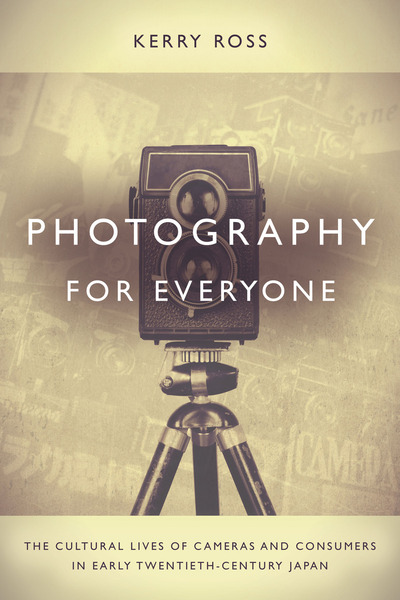
2015
256 pages.
from $32.00
Paperback now $16.00 (50% off)
Hardcover ISBN: 9780804794237
Paperback ISBN: 9780804795647
Ebook ISBN: 9780804795630
The Japanese passion for photography is almost a cliché, but how did it begin? Although Japanese art photography has been widely studied this book is the first to demonstrate how photography became an everyday activity. Japan's enthusiasm for photography emerged alongside a retail and consumer revolution that marketed products and activities that fit into a modern, tasteful, middle-class lifestyle. Kerry Ross examines the magazines and merchandise promoted to ordinary Japanese people in the early twentieth century that allowed Japanese consumers to participate in that lifestyle, and gave them a powerful tool to define its contours. Each chapter discusses a different facet of this phenomenon, from the revolution in retail camera shops, to the blizzard of socially constructive how-to manuals, and to the vocabulary of popular aesthetics that developed from enthusiasts sharing photos. Ross looks at the quotidian activities that went into the entire picture-making process, activities not typically understood as photographic in nature, such as shopping for a camera, reading photography magazines, and even preserving one's pictures in albums. These very activities, promoted and sponsored by the industry, embedded the camera in everyday life as both a consumer object and a technology for understanding modernity, making it the irresistible enterprise that Eastman encountered in his first visit to Japan in 1920 when he remarked that the Japanese people were "almost as addicted to the Kodak habit as ourselves."
About the author
Kerry Ross is an Assistant Professor in the Department of History at DePaul University.
"Kerry Ross uses amateur photography splendidly as a lens on the emergence of dynamic consumer cultures in Japan before World War II. Gender, marketing, aesthetics, work and leisure, and 'middlebrow' aesthetics all enter the picture—making for a major contribution to our growing appreciation of early 20th-century modernity."
—John W. Dower, MIT
"This study is highly original and provides a much needed account of prewar Japanese photography as a modernity-making social formation. The research opens up whole new worlds to historians of Japanese culture, commerce, gender, everyday life, and even nationalism/democracy."
—Paul D. Barclay, Associate Professor of History, Lafayette College
"Photography for Everyone provides thought-provoking analysis of the commercial and cultural forces that shaped amateur photography, adding much to our understanding of complex and sometimes competing photographic practices that developed in Japan in the 1920s and 1930s."––Kari Sheperdson-Scott, Pacific Affairs
"Ross's Photography for Everyone is a must-read for anyone interested in the impact of industry and the adoption of state-of-the-art technology by everyday Japanese consumers at the dawn of the twentieth century. It is also relevant to historians of photography, as it opens windows into the development of the photographic industry, and its understanding (and even grooming) of its consumers into gendered, technologically advanced, and democratic participants in the production of visual culture in the first decades of the twentieth century."
—Celio H. Barreto, H-Japan